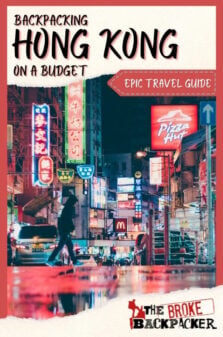Few cities exemplify a blend of east meets west quite like Hong Kong. It’s technically China, but at the same time, it isn’t. In this former British colony that’s now a Special Administrative Region of China, you can feast on dim sum or American barbecue. While you’ll certainly hear a lot of Cantonese and quite a bit of Mandarin, most people here also speak English.
It can be said that Hong Kong is – in fact – a city with split personalities. Looking at much of the architecture and double-decker buses driving on the left side of the road, it appears quite British. Walk down a random alley full of neon-lit signs and hawkers, and it’s suddenly very much Chinese.
Crossover to Kowloon, and you may mistakenly think you just arrived in India. Hong Kong certainly earns its nickname of Asia’s World City.
While you may think of towering skyscrapers and bustling markets, there’s far more to Hong Kong than that. This side of the city is jokingly referred to as Hong Koncrete, and it is indeed where package tour groups from the mainland spend a majority their time.
That’s not why you’re reading this, though. You’re here to find out what hidden secrets lay beyond the crowded streets and luxury shops of Hong Kong. Well, my friends, you’ve come to the right place.
Backpacking Hong Kong can and should be an adventure with many twists and turns. Of course, you’ll want to see the city, but you can also get out to the New Territories to do some hiking and camp out on secluded beaches on the islands. There’s much more to Hong Kong than meets the eye, and those who stay a while to explore its many sides will be rewarded.
Hong Kong may not be the cheapest backpacker destination, but there are plenty of ways to make your money stretch here. In this Hong Kong travel guide, we’ll give you tons of tips about where to stay and eat, how to get around, and what to do.

Photo: Sasha Savinov
The Broke Backpacker is supported by you. Clicking through our links may earn us a small affiliate commission, and that's what allows us to keep producing free content 🙂 Learn more.
It’s true that Hong Kong is more expensive than many other places in the region. Coming over from the mainland on my first trip, there was definitely a bit of sticker shock at the price of things. That being said, the old adage that you get what you pay for certainly rings true here.
Hong Kong is a quality destination in every aspect, so it’s well worth it to pay a little more than you would when backpacking China. And if you do it right, it’s totally possible to do Hong Kong on the cheap.
At the low end of the spectrum, you can get by on around $45-50 a day. This budget would include a dorm bed in one of the cheaper hostels, using public transportation (or walking), eating at markets or from street vendors, and taking advantage of the city’s many free activities.
If you up the daily budget to around $75-80, you could share a double room, hit a decent restaurant or two, and partake in some of the city’s raucous nightlife.
Hong Kong Daily Budget Breakdown
Here’s a breakdown of a daily Hong Kong budget:
Dorm bed in a hostel: $15-25
Small basic room for two: $30-40
Airbnb in a shared apartment: $40-50
Ride on the metro: $1-4
Airport express train: $15
History Museum: $1.25
Street food meal:$3-4
Dim sum for two: $20-25
Beer from a 7-11: $1.50-2
Beer at the bar: $8-10
Hong Kong Budget Backpacking Tips
If you’re planning a trip to Hong Kong, chances are you’ve read or heard that the city can be quite expensive. Don’t get discouraged, because you can definitely backpack Hong Kong on a budget if you need to. Here are a few tips to help your money go further here:
- Couchsurf or camp: There’s a very active Couchsurfing community in Hong Kong, so if you’re an established surfer it shouldn’t be too hard to find someone to stay with for a couple of nights. There’s also great camping available in the outlying islands, so pitch a tent and save on accommodation costs for at least a few nights.
- Take the ferry: While the metro is great in Hong Kong, it’s actually more expensive than taking the ferry. You can cross from Hong Kong Island over to Kowloon for about $0.30. It’s cheaper and much more scenic than being underground.
- Do free stuff: There are plenty of fun activities in Hong Kong that cost absolutely nothing. Take a walk in Kowloon Park, stroll along the Avenue of Stars, and watch the nightly Symphony of Lights all without spending a cent.
- Eat like a local: This is common wisdom for broke backpackers, but it’s very essential here in HK. Stick to local markets and street vendors and you’ll eat like a king for pennies on the dollar. Don’t be tempted by all the fancy restaurants and western food, as they will shatter your budget.
- Pre-game hard: Check the daily budget table above and you’ll see that a beer in a bar costs way more than one from a store. If you plan on checking out the nightlife here, be sure to pre-game. If you only have to buy a drink or two you won’t break the bank on a night out.
- Pack a travel water bottle and save money every day!
As you can see, it’s definitely possible to travel to Hong Kong on the cheap. You can make new friends by crashing on their couch, enjoy scenic ferry rides, feast on incredible Cantonese food, and still go out on the town while sticking to a backpacker’s budget.
Why You Should Travel to Hong Kong with a Water Bottle
Plastic washes up on even the most pristine beaches… so do your part and keep the Big Blue beautiful
You aren’t going to save the world overnight, but you might as well be part of the solution and not the problem. When you travel to some of the world’s most remote places, you come to realise the full extent of the plastic problem. And I hope you become more inspired to continue being a responsible traveller.
Plus, now you won’t be buying overpriced bottles of water from the supermarkets either! Travel with a filtered water bottle instead and never waste a cent nor a turtle’s life again.

Drink water from ANYWHERE. The Grayl Geopress is the worlds leading filtered water bottle protecting you from all manner of waterborne nasties.
Single-use plastic bottles are a MASSIVE threat to marine life. Be a part of the solution and travel with a filter water bottle. Save money and the environment!
We’ve tested the Geopress rigorously from the icy heights of Pakistan to the tropical jungles of Bali, and can confirm: it’s the best water bottle you’ll ever buy!
View on REI Read the ReviewPlanning a trip to Hong Kong can be a bit confusing when you look at the map. That’s because the city is actually split into several districts – Hong Kong Island, Kowloon, the New Territories, Lantau Island, and the Outlying Islands.
When backpacking in Hong Kong, most travelers find themselves in Kowloon in the area known as Tsim Sha Shui. This is where you’ll find the infamous Chungking Mansions, also known as Hong Kong’s favorite ghetto. Here you can get a super cheap room, buy a used phone, and munch on amazing Indian food.
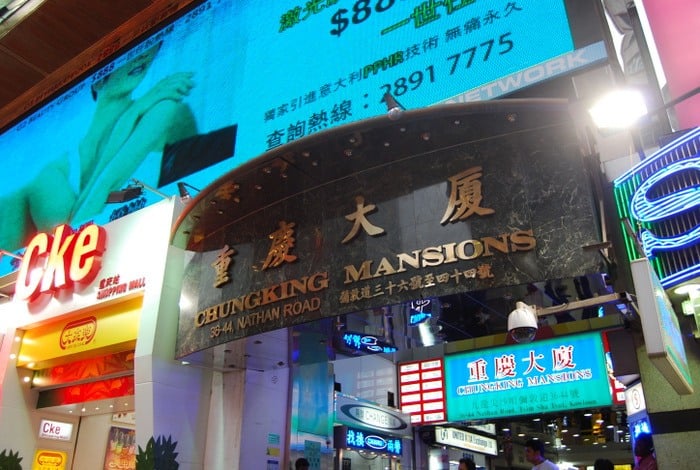
Photo: Sasha Savinov
More and more hostels are opening up over on Hong Kong Island. Most of these are located between Wan Chai and Causeway Bay. This is a good place to stay if you plan on partying hard in the nightlife hotspot known as Lan Kwai Fong.
There are also a few hostels over on Lantau Island if you feel like being away from the hustle and bustle.
The Best Places to Stay in Hong Kong
Are you wondering which is the best part of Hong Kong to stay in? Well, let me give you a few suggestions. You can also check out our neighbourhood guide for Where to Stay in Hong Kong for more information!
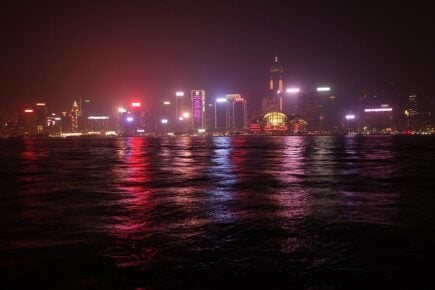
Tsim Sha Tsui
As one of the most central districts in the city, it’s little wonder Tsim Sha Tsui receives so many visitors and we believe it’s the best area to stay in Hong Kong on a first-time visit. The nightlife, cafes, and markets might also have something to do with it.
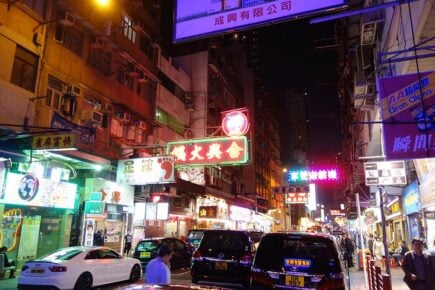
Mong Kok
Known to be a buzzy maze of backstreets, some people would rather run a mile than get lost in Mong Kok. However, once you get immersed, it’s one of the coolest neighborhoods in Hong Kong with flashing neon signs on every corner and plenty of cheap and cheerful authentic eateries.

Lan Kwai Fong
Hong Kong is a city that never sleeps. The neighborhood particularly prone to insomnia is Lan Kwai Fon, an area home to some of Asia’s best and busiest clubs.

Wan Chai
The quirky district of Wan Chai was once grubby and run-down, but nowadays it’s coming up as one of the most interesting districts in the city.

Causeway Bay
Causeway Bay is both the biggest retail district as well as the best area to stay in Hong Kong for families. While you could quite literally shop ’til you drop, there are plenty of other hidden gems in this densely populated neighborhood.
Want to save money on accommodation?
We got you. For reals.

A new country, a new contract, a new piece of plastic – booooring. Instead, buy an eSIM!
Jetpac eSIMs work just like an app: you download it, pick your plan, and BOOM! You’re connected the minute you land. It’s that easy.
Read about how e-Sims work or click below to see one of the top eSIM providers on the market and ditch the plastic.
Grab an eSIM!Hong Kong may be famous for its gorgeous skyline along Victoria Harbour, but there’s much more to this city than skyscrapers. As a matter of fact, over 70% of HK is countryside, full of parks, hiking trails, fishing villages, secluded beaches, and traditional temples.
If you’re willing to spend some time on the metro and ferries to take it all in, you can stack your days full of exciting activities. Here are our top 10 things to do in Hong Kong to give you an idea of what’s on tap here:
1. The Peak
At 552 meters, this is the highest peak on Hong Kong Island and a must-do on any Hong Kong itinerary. Way up here, you can enjoy breathtaking views of the harbour and the city. If you’re lucky and it’s a super clear day, you just might see the eight mountains of Kowloon as well.
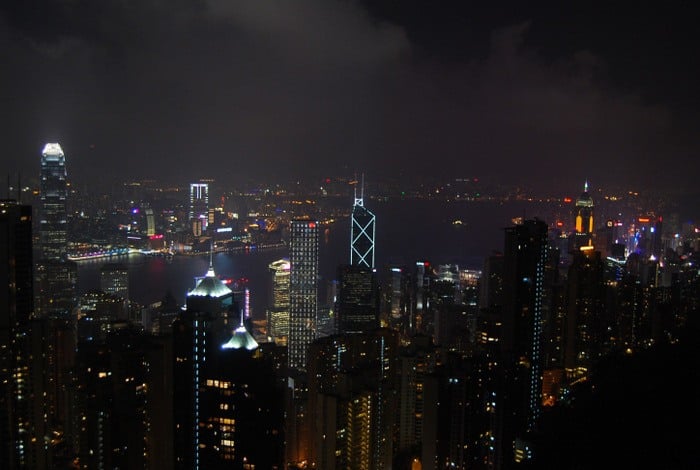
Photo: Sasha Savinov
2. Ride the Ferry
Another great way to appreciate the beautiful HK skyline is by taking the public ferry from Hong Kong Island to Kowloon or vice versa. Not only will you get to enjoy amazing views, but this will help ensure that you do Hong Kong on the cheap, as a ride only costs $0.30-50!
3. Eat Dim Sum
Cantonese food is one of the Four Great Culinary Traditions of China, and it’s perhaps the most famous variety of Chinese cuisine found around the world. The quintessential Cantonese dining experience is a dim sum brunch. Come hungry and choose between a wide variety of tasty morsels like pork buns or shrimp dumplings.
4. Hike and Camp in the Outlying Islands
Many travellers never escape the concrete jungle side of Hong Kong, which is a damn shame. It doesn’t take too long to find yourself hiking along a picturesque trail to a remote beach. Bring your camping gear and have a night under the stars far away from the crowds.
5. Lantau Island
There’s so much to do over on Lantau Island that you might just want to spend a few nights there. Ride the scenic cable car and pay a visit to the Tian Tan Buddha, which is the largest seated Buddha in the world. If you want to unleash your inner child, this is where you’ll find Hong Kong’s Disneyland.
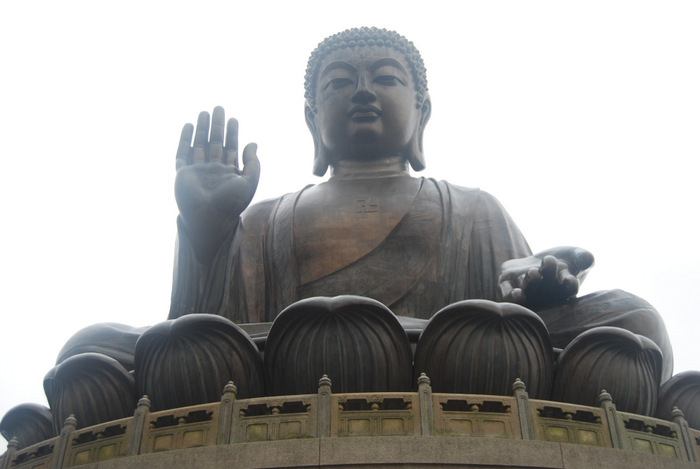
Photo: Sasha Savinov
6. Happy Valley Racecourse
Fun fact – horse racing is the only legal form of gambling in HK. For anything else, you’ll have to go to nearby Macau. That means huge crowds of locals flocking here for the weekly races that take place on Wednesdays between September and July. Tickets are cheap, the atmosphere is great, and best of all attire is casual. Leave the silly hats and bow-ties at home.
7. Avenue of the Stars and Symphony of Lights
The most scenic walk you can take in the city is along the aptly named Avenue of Stars. Here you’ll see statues of HK film legends such as Bruce Lee and Jackie Chan, which make for some great photo opps. If you stick around until after dark, you’ll be able to take in the amazing Symphony of Lights show on the harbour.
8. Hong Kong Museum of History
There aren’t a ton of museums in Hong Kong, which makes this an easy choice. The history museum is conveniently located in Kowloon and only costs around $1.50. It has some high-quality exhibits that will teach you a lot about the city and its history. Perhaps best of all, it’s an air-conditioned break from the heat and humidity. You will appreciate your Hong Kong visit much more once you have some historical context.
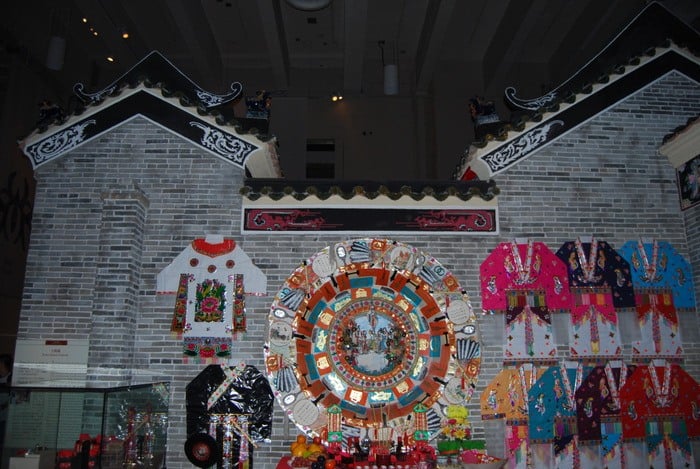
Photo: Sasha Savinov
9. Chill Out in the Park
You don’t have to go all the way to the New Territories or Outlying Islands to enjoy some green space in Hong Kong. The city is home to several excellent parks where locals like to go to chill out. Some of your best choices include Hong Kong Park, the Nan Lian Gardens, and Kowloon Park.
10. Party Hard in LKF
Hong Kongers work hard and they party even harder. There’s a favourite saying among locals and expats that “A New York minute is a Hong Kong second,” and it’s true that there’s always something exciting going on here. In the evenings and especially on weekends, the area known as Lan Kwai Fong (or LKF for short) is packed full of people who come for the wide array of restaurants and bars.
Now that we’ve covered some of the basics, it’s time to lay out an awesome itinerary for 3 days in Hong Kong:
Day 1 in Hong Kong: Classic HK
On your first day in the city, it’s best to go for the classic HK experience. After checking into your hostel, head out in search of dim sum. Be sure to arrive hungry so you can try a wide variety of the mouth-watering little morsels that are on offer. This is one of the best culinary experiences out there, and nobody does it quite like Hong Kong.
After that epic meal, you’ll need to go for a walk. Hop on the ferry and cross over to Kowloon. It’s super cheap and incredibly scenic, so be sure to have your camera ready.
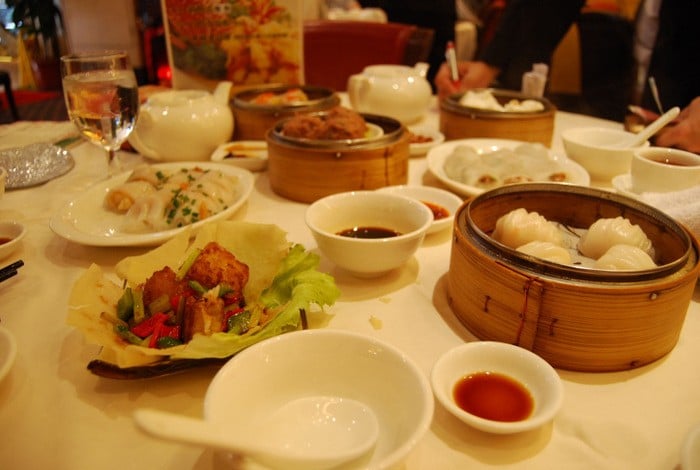
Photo: Sasha Savinov
On the other side, you’ve got plenty of options to pass the time. Check out the Hong Kong History Museum, take a stroll in Kowloon Park, or get lost wandering the maze-like aisles in the Chunking Mansions.
Just before the sun goes down, stroll along the Avenue of Stars to take your photo with the Bruce Lee statue. At 8 o’clock, you can catch the incredible Symphony of Lights show on Victoria Harbour. If you’re feeling fancy, you can even head out on a booze cruise for a better view and an open bar.
Stick around Kowloon and dive into the amazing street food scene. Wander around the Sham Shui Po area and feast on delicacies like curry fish balls, siu mai, and rice noodle rolls. Since tomorrow is going to be a big day, it’s best to just stick to a cheeky street beer or two and save the partying for another night.
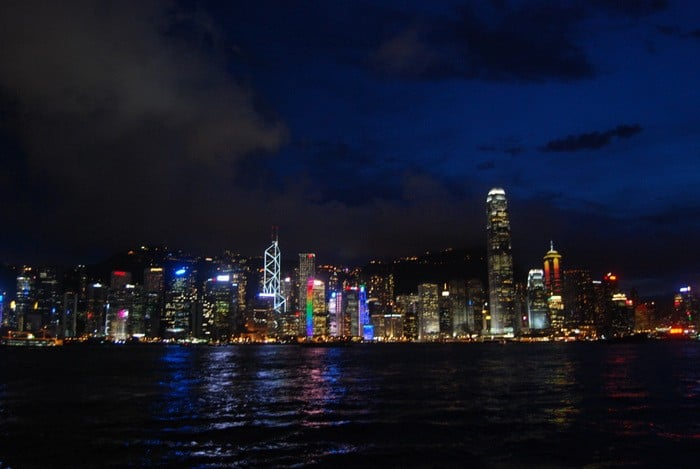
Photo: Sasha Savinov
Day Two in Hong Kong: Lantau Island, The Peak, and LKF
Now that you’ve seen a lot of the city, you can spend day two in Hong Kong out on Lantau Island. You can get out there by a scenic (albeit a bit slow) ferry, or you can take a combination of the metro plus the cable car. You might have to queue up and wait for a while, but it’s well worth it.
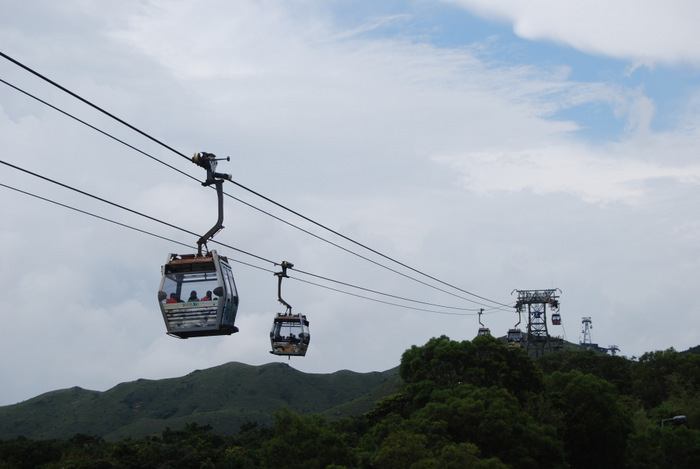
Photo: Sasha Savinov
Your first order of business should be checking out the giant Tian Tan Buddha. Standing at 34 meters and weighing in at a whopping 250 tonnes, this is the largest seated, outdoor, bronze Buddha statue in the world. It’s quite the impressive sight and is one of the most famous images of HK.
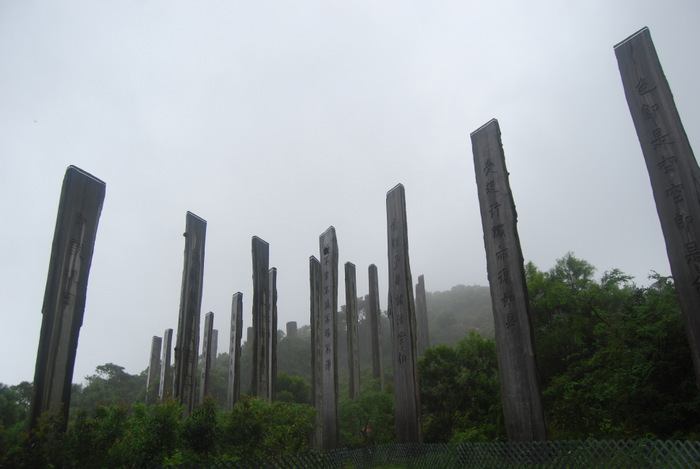
Photo: Sasha Savinov
Next up, you can take a peaceful stroll along the Wisdom Path and head over to the Po Lin Monastery. This lovely temple has three statues representing the Buddha of the past, present, and future.
You could also consider trying to check out Tai O, which is a traditional fishing village where you can eat some amazing fresh seafood.
Once you’re back in Hong Kong, you can catch the tram up to The Peak. If you can time it right around sunset, you’ll be able to watch the lights come on across the city. It’s definitely one of the best views in all of HK and as such is one of the most popular attractions in the city.
Finally, head to the Lan Kwai Fong area for dinner and drinks. This is one of the most happening districts for nightlife in Hong Kong, so your options are plentiful. It may be a late night out, but that’s fine. Tomorrow will be a chill one after a hectic couple of days.
Day Three in Hong Kong: Straight Chillin’
Since you’ve already crossed all the big items off the list, day three in Hong Kong can be a relaxing one. If you care to indulge in one of the best remnants of the British occupation, you’ve got lots of options for having high tea. The Peninsula is one of the best, but you’ll have to get there early to beat the queue.

Photo: Sasha Savinov
After tea, you can catch the ferry once again to head over to the other side. A walk in Hong Kong Park is in order after that glutinous morning. This is one of the best green spaces in the city, so take your time and enjoy it. There’s an aviary, a Tai Chi Garden, and much more here.
While you’re over here, you might as well check out the world’s longest escalator. It connects Central to the Mid-level area of HK, passing through the Soho neighborhood.
It runs down during the morning rush hour, but up the rest of the day. You’ll pass through some of the oldest streets in Hong Kong, so this is the perfect opportunity for some aimless wandering.
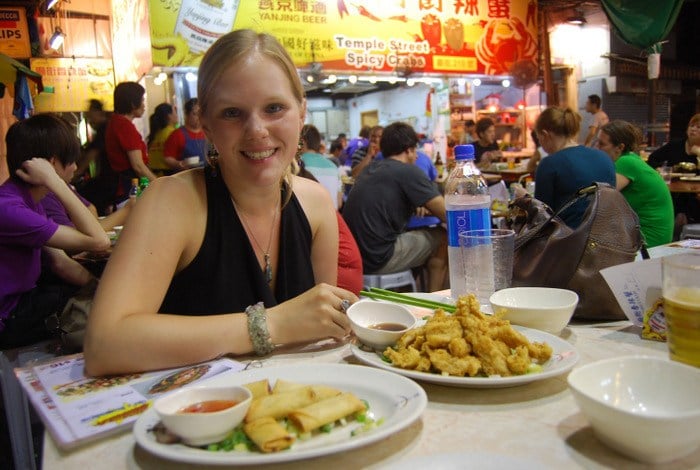
Photo: Sasha Savinov
Since you had a fancy afternoon, it’s time to get back into the local scene for dinner. Choose between the Ladies’ Market or the Temple Street Night Market and dig in to more delicious Cantonese street food.
This is also the perfect opportunity to pick up some souvenirs to bring home. Just be sure to bargain! Wind down the evening by finding a local pub or grabbing some cheap beers from the store to bring back to the hostel.
Hong Kong Off the Beaten Track
It’s very easy to get off the beaten track in Hong Kong. All you need to do is spend a little time on the city’s great public transportation network to get up to the New Territories or down to the Outlying Islands.
As you can see from the jam-packed 3-day itinerary above, it’s hard to make time to visit either of these parts of HK on a short trip. There’s so much to see and do on Hong Kong Island, Kowloon and Lantau, and most travellers simply don’t have enough time to visit the more far-flung sections of the city.
Up in the New Territories, you’ll find plenty of excellent trails to walk along and enjoy the mountainous scenery. While you’re here, you can also visit the Hong Kong Wetland Park, the informative Heritage Museum, or the 10,000 Buddhas Monastery.
You can catch the best sunset in HK from Ha Pak Nai beach, which is just across the water from the mainland city of Shenzhen.

Photo: Sasha Savinov
There are actually 234 islands, islets, and rocks that comprise the area known as the Outlying Islands. If you’re just backpacking Hong Kong for a week or less, there are only a few that you might visit.
With the exception of Lantau, none of the islands allow cars. If you’ve been in Asia for a while, dodging motorbikes and tuk-tuks, a trip to the Outlying Islands is a great escape.
Lamma Island has become a popular place for Western hippies looking for an alternative lifestyle to stay a while. Most people stay in the Yang Shue Wan area on the northern side of the area, and this where you can find hostels, restaurants, and bars.
If you’ve got a few days to spare, a short stay here would be a great way to wind down after running around exploring all that the city has to offer. Go for leisurely hikes, chill out on the beach, enjoy delicious seafood, and go out for chill nights in the local bars.
Best Walks in Hong Kong
Despite its status as a sprawling metropolis, there are plenty of excellent walks and hikes in Hong Kong. These range from casual strolls through the city to multi-day hiking excursions. Assuming you’re just travelling in Hong Kong for a couple of days, here are some of the best walks you can consider.

Photo: Sasha Savinov
Walking Tour of Kowloon: It’s very straightforward to give yourself a walking tour of Kowloon. In just a couple of hours, you can easily make a loop that allows you to visit Kowloon Park, the History Museum, and the Avenue of Stars. If you do this walk later in the day, you can catch the Symphony of Lights show on the harbour, which starts around 8PM.
Big Buddha: There are around 70 km of hiking trails on Lantau Island. One option that only takes about three hours is walking from Pak Kung Au to Ngong Ping. Once you get there, you can visit the Big Buddha and the Po Lin Monastery.
Ping Shan Heritage Trail: If you make it up to the New Territories, this is a very easy walk that brings you past the most important historical buildings in the area. You’ll see pagodas, shrines, ancestral halls and more. Here’s a comprehensive guide with a map of this trail and many others.
Best Time of Year to Visit Hong Kong
It’s said that the best time of year to visit Hong Kong is between October and December. The days are usually clear, sunny, and pleasant this time of year. It’s nice and warm and there aren’t too many rainy days, making this the perfect time to get into some hiking and camping here.

Photo: Sasha Savinov
It should be mentioned that October 1st is China’s National Day. In the week around this important holiday, there are an insane amount of tourists from the mainland in Hong Kong. The same is true during the Spring Festival, which varies from year to year as it’s based on the lunar calendar.
Spring is pretty nice in Hong Kong as well, but the weather can change in an instant. You’re likely to encounter rain and fog if travelling here from March to May. The summer months in HK are very hot and humid, and there’s always a chance of a thunderstorm or even a typhoon.
Winter means cooler temperatures, but you’ll be fine with a jumper. Christmas and New Year’s are both very festive in HK, but you’ll want to book in advance and will probably pay higher rates.
Getting in and out of Hong Kong
You’ve got a few options for getting in and out of Hong Kong. Many travellers arrive at the Hong Kong International Airport, which has actually received the honour of “World’s Best Airport” on eight occasions by Skytrax.
There are more than 100 airlines here operating flights to 180 destinations all over the world. You can basically fly to any corner of the globe direct from Hong Kong.

Photo: Sasha Savinov
The airport is located on the island of Chek Lap Kok. Your best bet for getting to and from is the Airport Express train. Tickets cost around $15 for a one-way and $25 for round-trip, and the trip takes about half an hour to reach Central.
If you don’t have a lot of luggage and you don’t mind a longer trip with a connection or two, you could take a combination of bus and metro to reach the city.
You also have a few options for travelling to Hong Kong by land or by sea. It’s possible to cross the border into mainland China via the city of Shenzhen. You have to take the metro and go through check points and immigration.
Yes, Hong Kong is technically China, but there’s a big difference between travelling there and mainland China. Many people don’t need a visa to visit HK, but do in fact need one to visit the mainland.
Another option is taking a ferry over to Macau. These fast ferries get you between the two Special Administrative Regions of China in just one hour and run all day. There are also ferries that travel between Hong Kong and several points in Guangdong province, such as Zhuhai or Zhongshan.
How to get around Hong Kong
Getting around Hong Kong is a breeze, thanks to the city’s excellent public transportation. If you’re staying more than a day or two, it’s worth it to pick up a rechargeable Octopus card.
A basic card costs about $20, which is around $12 in credit and an $8 refundable deposit. You can use the card to ride all the various forms of public transport here and you can even use it to pay for things in convenience stores, supermarkets, and some restaurants.
The MTR (Mass Transit Railway) is definitely the fastest way to get around Hong Kong. There are several lines that connect all points of the city and you can even take it all the way to the border with mainland China.
The city also has an extensive network of double-decker trams that are often referred to as ding ding in Cantonese. Riding these and sitting on the top level is a great way to see the city for cheap.
You might not really need to take them, but there are plenty of bus lines as well, including several that are also double-decker. Taxis are readily available and reasonably priced in Hong Kong. You usually don’t need to worry about haggling with drivers or getting ripped off here.
When going between Hong Kong Island and Kowloon, you should definitely ride the ferry. It’s cheaper and far more scenic than riding the tube. There are also ferries that bring you to Lantau and some of the other Outlying Islands if you don’t mind a slightly longer trip.
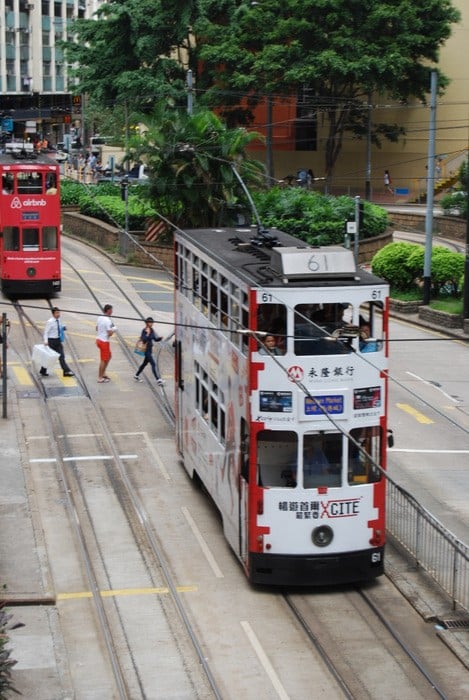
Photo: Sasha Savinov
Long Distance Trains from Hong Kong
You have a few options for travelling to or from Hong Kong by train. The Hung Hom Station on the Kowloon side has regular trains to a few cities in China’s Guangdong province, such as Guangzhou and Dongguan. It’s a short trip of just an hour or two to get between HK and these cities.
There are also trains twice a day to both Beijing and Shanghai. These journeys take around 20-24 hours, so you’ll definitely want to invest in a sleeper ticket.
A hard sleeper to Beijing costs around $75 while a soft sleeper will run you $120. It’s a long trip, and one I’m glad I only had to take once! My favorite resource for finding train times and even buying tickets is the China Travel Guide.
Rather than just showing up at the train station, you can now book tickets in advance for most of Asia using Bookaway – I love 12Go and use it myself pretty often when backpacking around Asia.
Safety in Hong Kong
Safety isn’t a huge concern here, as Hong Kong is one of the safest cities in the world. That being said, there’s are the usual city problems like pick-pocketing. Be aware of your valuables, especially if you’re riding a crowded metro or walking through a packed market.
Those planning on doing some serious hiking here should be prepared with detailed maps, a compass, and a working mobile phone. Several hikers have gone missing or even lost their lives hiking in the Hong Kong wilderness in recent years. Unless you’re a seasoned pro, you should plan on going with a group for any seriously challenging hikes.
Travel Insurance for Hong Kong
Traveling without insurance would be risky so do consider getting good backpacker insurance sorted before you head off on an adventure.
ALWAYS sort out your backpacker insurance before your trip. There’s plenty to choose from in that department, but a good place to start is Safety Wing.
They offer month-to-month payments, no lock-in contracts, and require absolutely no itineraries: that’s the exact kind of insurance long-term travellers and digital nomads need.
SafetyWing is cheap, easy, and admin-free: just sign up lickety-split so you can get back to it!
Click the button below to learn more about SafetyWing’s setup or read our insider review for the full tasty scoop.
Hong Kong Accommodation Travel Hacks
Accommodation costs more in Hong Kong than many other Asian cities. You won’t find any $5 dorm beds here, but it is possible to get a place for around $15. Try to find a hostel in Hong Kong that at least includes free breakfast or has a kitchen so you can save some money on meals.
If you’re looking for a private room, the cheapest options can be found in the Chungking Mansions. Don’t let the name fool you, as this place is anything but a mansion. It’s not that nice, but you can score a private air-conditioned room for around $30 a night. Just don’t be surprised to find that it’s the size of a closet.
There’s an active Couchsurfing community in Hong Kong, so it’s definitely worth it to do a search and send out a few requests in the weeks leading up to your trip. You’ll not only get free accommodation but might also make new friends.
We had a great experience crashing on a really cool expat’s couch when we travelled to Hong Kong, and my wife even went back and stayed with him again when she had to do a visa run.
Eating and Drinking in Hong Kong
Food is a huge part of life here in Hong Kong, especially eating out. Since most people live in pretty cramped apartments, it’s not really common to cook and socialize at home. Instead, locals meet at local markets for street food or go to a restaurant. There are definitely people in HK who haven’t cooked a meal in years!
The quintessential Hong Kong dining experience is dim sum. These places are usually busy a bit late in the morning, as it’s the Cantonese equivalent of brunch.
Basically, you just sit at a table and watch as servers push around carts full of tasty little morsels like shrimp dumplings and BBQ pork buns. Take what you like and be sure to try a bunch of different plates, sipping Chinese tea in between.
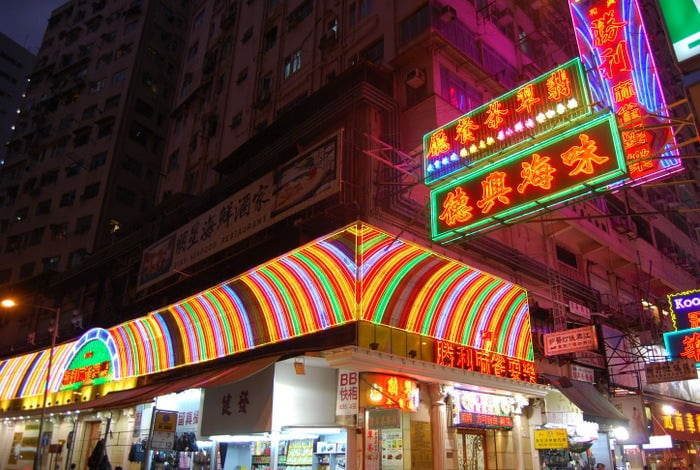
Photo: Sasha Savinov
For those looking to do Hong Kong on the cheap, you’ve got countless options when it comes to local food courts and street food. Most of the night markets are located on the Kowloon side, and you can easily get dinner for just $4-5. If you need a break from Cantonese food but still want to eat cheap, head into the Chungking Mansions and feast on some amazing Indian food.
As a major international city, Hong Kong is home to just about every type of cuisine imaginable. It’s not hard to find fast food chains that you’re used to and some that you’re not.
You can also sit down to Italian, Mexican, Korean, and everything in between. However, if you’re only here for a couple of days I highly recommend sticking to the local stuff. It’s cheap and it’s delicious, so why look elsewhere?
Hong Kongers love their tea, and a pot of it is usually served with a meal when you sit down in a restaurant. Be sure to tap two or three fingers on the table to thank whoever pours your tea. Don’t ask me why – it’s just what they do here! If you’d rather have a coffee, it’s not hard to find a cafe to sit down and enjoy a cup.
As far as booze goes, there’s a big difference between buying it in a store and in a bar. You can pick up a beer for just around $1.50 or so from a convenience store, but you’ll spend closer to $8 in a bar, and even more for a good cocktail.
For Hong Kong cooking classes, check out this site for awesome deals.
Nightlife in Hong Kong
Just because drinking is a bit expensive in Hong Kong doesn’t mean you can’t go out and partake in the city’s great nightlife. It’s best to pre-game hard at the hostel and find Happy Hours here before going out. There are a few main areas for partying in HK – Lan Kwai Fong and Wan Chai in Central, and Knutsford Terrace in Kowloon.
You need to be 18 to get into bars and clubs in Hong Kong, and they might actually ask to see your ID if you look young. Speaking of getting into bars, many of them have a dress code. It may be hot in HK, but you’ll probably need to put on pants and shoes before going out.
The good news about partying here is that street beers are not really a problem. It’s fun to just grab a beer from 7-11 and wander around a night market trying different foods, then head to LKF and do the same until you’ve got a healthy buzz and have found a bar that has decent deals.
Ladies should keep an eye out during the week for bars that have free entry and maybe even drinks. Sorry, dudes – you’re on your own.
There are plenty of night clubs to choose from, but that’s not really my scene. You’ll have to queue up just to get in, pay a cover charge, and be stuck with overpriced drinks and offensively loud music. You can have plenty of fun on a night out in HK without stepping foot into a nightclub.
Books on Hong Kong
Lonely Planet Hong Kong Travel Guide – There’s so much to do in HK that there’s an entire Lonely Planet guide dedicated to it!
A Modern History of Hong Kong – From a small fishing community to one of the world’s biggest metropolises, learn the history of HK in this great book.
No City for Slow Men – Hong Kong’s Quirks and Quandries Laid Bare – A fascinating look at Hong Kong and the social issues facing the city in 36 essays.
Hong Kong – A Jake Grafton Novel – A Stephen Coonts thriller, and one of the best books set in Hong Kong.
Volunteering in Hong Kong
Long term travel is awesome. Giving back is awesome too. For backpackers looking to travel long-term on a budget in Hong Kong whilst making a real impact on local communities, look no further than World Packers. World Packers is an excellent platform connecting travelers with meaningful volunteer positions throughout the world.
In exchange for a few hours of work each day, your room and board are covered.
Backpackers can spend long periods of time volunteering in an awesome place without spending any money. Meaningful life and travel experiences are rooted in stepping out of your comfort zone and into the world of a purposeful project.
Worldpackers opens the doors for work opportunities in hostels, homestays, NGOs, and eco-projects around the world. We’ve tried and approved them ourselves – check out our Worldpackers in-depth review here.
If you’re ready to create a life-changing travel experience and give back to the community, join the Worldpacker community now. As a Broke Backpacker reader, you’ll get a special discount of $10. Just use the discount code BROKEBACKPACKER and your membership is discounted from $49 a year to only $39.
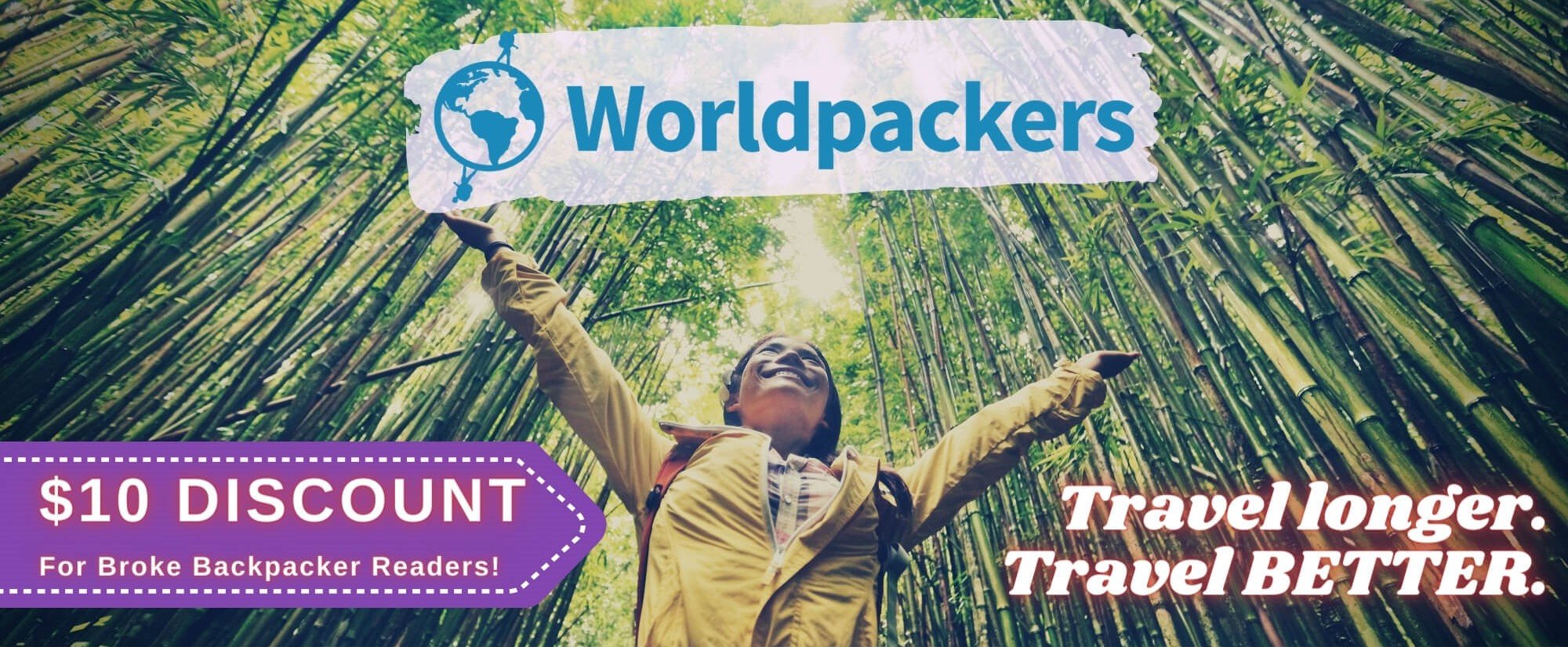
Worldpackers: connecting travellers with meaningful travel experiences.
Make Money Online Whilst Backpacking Hong Kong
Traveling in Hong Kong? Keen to make some cash when you are not exploring the city?
Teaching English online is a great way to earn a consistent income—from anywhere in the world with a good internet connection. Depending on your qualifications (or your motivation to obtain qualifications like a TEFL certificate) you can teach English remotely from your laptop, save some cash for your next adventure, and make a positive impact on the world by improving another person’s language skills! It’s a win-win! Check out this detailed article for everything you need to know to start teaching English online.
In addition to giving you the qualifications to teach English online, TEFL courses open up a huge range of opportunities and you can find teaching work all over the world. To find out more about TEFL courses and how you can teach English around the world, read my in-depth report on teaching English abroad.
Broke Backpacker readers get a 50% discount on TEFL courses with MyTEFL (simply enter the code PACK50), to find out more, please read my in-depth report on teaching English abroad.
Whether you are keen to teach English online or looking to take your teaching game a step further by finding a job teaching English in a foreign country, getting your TEFL certificate is absolutely a step in the right direction.
Being a Responsible Backpacker in Hong Kong
Reduce your plastic footprint: Perhaps the best thing you can do for our planet is to make sure you do NOT add to the plastic problem all over the world. Don’t buy one-use water bottles, the plastic ends up in landfill or in the ocean. Instead, pack a tough travel water bottle.
Go and watch A Plastic Ocean on Netflix – it’ll change how you view the plastic problem in the world; you need to understand what we are up against. If you think it doesn’t matter, get off my fucking site.
Don’t pick up single use plastic bags, you’re a backpacker – take your daypack if you need to go to the shop or run errands.
Bear in mind, that many animal products in countries you travel through will not be ethically farmed and won’t be of the highest quality. I’m a carnivore but when I’m on the road, I only eat chicken. Mass-farming of cows etc leads to the rainforest being cut down – which is obviously a huge problem.
Need more guidance? – Check out our post on how to be a responsible backpacker.
Backpacking in Hong Kong will bring you ample opportunities to participate in debauchery, and it is very important to have fun, let loose, and get a bit wild at times. Most backpacking trips I have been on across the world have included at least a few mornings where I wake up knowing I went too far.
There are some things that will put you in the category of a straight up jackass if you do them. Being super loud and obnoxious in a tiny hostel at 3 AM is a classic rookie backpacker mistake. Everyone in the hostel will hate you when you wake them up. Show your fellow travelers respect whilst backpacking in the UK, and anywhere else for that matter!
Climbing on important monuments, or other historical artifacts should be avoided. Learn to appreciate the cultural treasures of Hong Kong and don’t be that dickhead who adds to their demise.
Buy Us a Coffee!
A couple of you lovely readers suggested we set up a tip jar for direct support as an alternative to booking through our links. So we created one!
You can now buy The Broke Backpacker a coffee. If you like and use our content to plan your trips, it’s a much appreciated way to show appreciation 🙂





